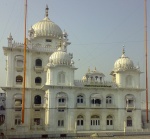Template:AOW345: Difference between revisions
Hari singh (talk | contribs) (Created page with '{{aowh|Takhat Sachkhand Sri Patna Sahib}} {{pm|File:Takhat Patna Sahib-m.jpg|'''Takhat Patna Sahib'''}} It was here at Takhat Patna Sahib, that Guru Gobind Singh…') |
Hari singh (talk | contribs) No edit summary |
||
| Line 2: | Line 2: | ||
{{pm|File:Takhat Patna Sahib-m.jpg|'''[[Takhat Patna Sahib]]'''}} | {{pm|File:Takhat Patna Sahib-m.jpg|'''[[Takhat Patna Sahib]]'''}} | ||
It was here at | It was here at [[Takhat Patna Sahib]], that [[Guru Gobind Singh]], the tenth [[Sikh]] Guru was born in [[1666]]. He also spent his early years here before moving to [[Anandpur]]. Besides being the birthplace of Guru Gobind Singh, [[Patna]] was also honored by visits from [[Guru Nanak]] as well as [[Guru Tegh Bahadur]]. | ||
This is one of only five [[Takhat]]s or '' | This is one of only five [[Takhat]]s or ''"Seats of Authority"'' of the [[Sikh]]s. The [[Gurdwara]] [[Patna]] Sahib was constructed in honour of [[Guru Gobind Singh]]; like many historical [[Gurdwara's]] in [[India]] and [[Pakistan]], this present Gurdwara was initially built by [[Maharaja Ranjit Singh]]. | ||
Originally, at this place stood the haveli of [[Salis Rai Jouri]], who was a great devotee of [[Guru Nanak]]. He was so much influenced by the teachings of the [[Guru]] that he converted his palatial home into a [[dharamsala]] (place where [[dharam]] is learned). | Originally, at this place stood the haveli of [[Salis Rai Jouri]], who was a great devotee of [[Guru Nanak]]. He was so much influenced by the teachings of the [[Guru]] that he converted his palatial home into a [[dharamsala]] (place where [[dharam]] is learned). | ||
When [[Guru Tegh Bahadur]] visited [[Patna]], he stayed in this exact site. A magnificent house was built above the [[dharamsala]] of Salis Rai. <!----Mullah Ahmed Bukhari, the author of Mirat-ul-Ahwal Jahan Nama, who stayed at Patna for some time at the close of 18th century, has made a reference to "Harmandir Sahib". He writes, "Over the birthplace of [[Guru Gobind Singh]], the Sikhs have raised a public edifice, made it a place of power and strength, and call it 'Harmandir'. --->{{aowf|Takhat Sachkhand Sri Patna Sahib}} | When [[Guru Tegh Bahadur]] visited [[Patna]], he stayed in this exact site. A magnificent house was built above the [[dharamsala]] of Salis Rai. <!----Mullah Ahmed Bukhari, the author of Mirat-ul-Ahwal Jahan Nama, who stayed at Patna for some time at the close of 18th century, has made a reference to "Harmandir Sahib". He writes, "Over the birthplace of [[Guru Gobind Singh]], the Sikhs have raised a public edifice, made it a place of power and strength, and call it 'Harmandir'. --->{{aowf|Takhat Sachkhand Sri Patna Sahib}} | ||
Latest revision as of 17:47, 19 November 2009
It was here at Takhat Patna Sahib, that Guru Gobind Singh, the tenth Sikh Guru was born in 1666. He also spent his early years here before moving to Anandpur. Besides being the birthplace of Guru Gobind Singh, Patna was also honored by visits from Guru Nanak as well as Guru Tegh Bahadur.
This is one of only five Takhats or "Seats of Authority" of the Sikhs. The Gurdwara Patna Sahib was constructed in honour of Guru Gobind Singh; like many historical Gurdwara's in India and Pakistan, this present Gurdwara was initially built by Maharaja Ranjit Singh.
Originally, at this place stood the haveli of Salis Rai Jouri, who was a great devotee of Guru Nanak. He was so much influenced by the teachings of the Guru that he converted his palatial home into a dharamsala (place where dharam is learned).
When Guru Tegh Bahadur visited Patna, he stayed in this exact site. A magnificent house was built above the dharamsala of Salis Rai. .....More

